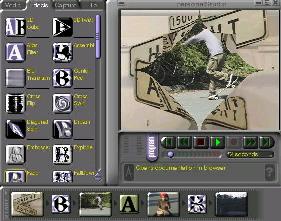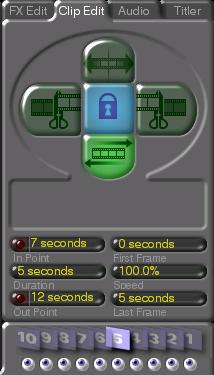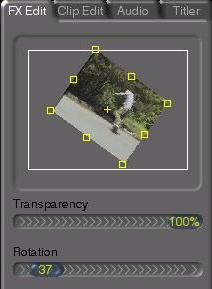Real-Time DV in BeOS
Non-Linear Video Editing with personalStudio
Scot Hacker, 2/23/00In preparation for my upcoming wedding, honeymoon, and the hopefully soon-to-come pitter patter of little Hackers, I recently invested in a digital video camera (a Sony TRV-8). Of course, taping my life is only half the game -- the other half is the non-linear editing process I'll be using to turn raw footage into semi-professional, finished productions for export back to video tape. I also want to start creating video collage, self-indulgent art flicks, and impromptu music videos.
But as I've said many times before, BeOS has spoiled me rotten, and I'm not about do my NLE work in Windows. Linux drives me batty (and doesn't have much of a media foundation), and I don't own a Mac, so that means I needed an NLE solution for BeOS... soon. The question of the month, therefore, is whether I can do all I want to do, video-wise, in BeOS or whether I'll be forced to boot a lesser OS to get the job done.
My timing couldn't have been better. As it turns out, BeOS R5 (which I've been beta testing for a couple of months) includes IEEE-1394 (FireWire) support, which means I can get video data from camera to hard disk and back again. It also means that BeOS video applications can take advantage of the new 1394 support easily (my reading of rec.video.desktop indicates that things aren't quite so elegant for Windows DV application vendors). Meanwhile, Adamation has provided me with beta copies of their NLE suite personalStudio 1.5, which takes full advantage of Be's new FireWire capture capabilities. I'm ready to rock.

Adamation's personalStudio is a complete non-linear DV editing package for BeOS with IEEE-1394 support. Click for larger version.
personalStudio Overview
Like personal DV packages for other platforms, personalStudio lets you drag video clips, audio segments, and still images into a Media panel defining the raw content of a project. From there, media can be dragged into a Storyboard, from which you control the basic order of your clips. Each clip is separated by one of 48 different transition effects. The front and back of clips can be trimmed or extended, and clips can be shifted back and forth in time. To tightly control the placement of multiple simultaneous clips, media can be dropped into any of ten layers, each of which can be optionally viewed or hidden with the click of an eyeball. Clips can be moved around, resized, or rotated on the canvas with the FX Edit panel. A Titler panel lets you create custom credits or annotations with the same degree of control you get with other media.Most of that is standard fare for a consumer NLE package. So what sets personalStudio apart from the competition? Two words: No rendering.
If you've ever used NLE software for MacOS or Windows, you're probably accustomed to putting your feet up on the desk and waiting every time you change a transition or apply an effect. Waiting for effects to render may be the single-most time consuming aspect of video editing under Windows and MacOS, and drives people to spend gobs of money on faster processors.
In personalStudio, you always work directly on a preview of your presentation. Only when you're ready to save it to disk or export back to a camera do you render. Projects-in-process can even be saved and resumed later on without rendering first. Never having to render means you can do things like drag a transition from the Effects panel and have it appear immediately in the Preview window. In fact, you can even change a transition, or move, resize, and rotate a movie while it's playing.

Transitions and other effects can be changed while a movie is being played. Here we've just changed the Fade transition to Center Peel as the presentation rolled. Click for larger version.
Adamation is using heavily multi-threaded BeOS technology to its fullest advantage, and the effect is dramatic. Video professionals will attest that this kind of thing is typically only seen in very expensive, dedicated hardware/software solutions on other platforms. In contrast, personalStudio can do real-time video effects processing on consumer-grade hardware.
And it's cheap. While I wasn't able to get a final price prior to press time, Adamation did tell me they planned to start offering a bundle including an ADS Pyro 1394 card, FireWire cable, and personalStudio 1.5 for around $100 -- less than a similar bundle for Windows which includes the less-intuitive and less-capable ULead VideoStudio. And with BeOS about to become freely downloadable, don't be surprised if Adamation throws in a copy of BeOS itself, which will make it easy for Windows users to get a copy of BeOS and try out personalStudio at the same time.
Soundtrack Heaven
Because the non-free version of BeOS 5 includes MP3 codecs as central system objects available to all applications, you can now milk your existing MP3 collection as source material for movie soundtracks. Just drag MP3, WAV, or AIFF files into the Media panel and use them like any other media clips (I recommend putting audio on separate layers from video, just for good housekeeping). Of course, you can trim the front or back of your audio clips, or use the Audio panel to adjust the fade in and fade out points, relative volume, and master volume for the whole presentation. It's amazing how a short presentation is instantly transformed with the addition of some good music.Of course, BeOS includes multitrack audio editing software in the form of 3dmiX, so you can create custom soundtracks outside of personalStudio and then import them later. On the other hand, if all you want to do is arrange a few pre-existing audio clips in time, you can use personalStudio's Layers feature to accomplish your goal.
Stills, Transparency, Rotation and Titles
Still images can add more to a movie than you might expect, and can be used to illustrate concepts, break up the flow of a presentation, or to just be funky. Used in combination with the new Titler in personalStudio 1.5, you can even create credit sequences over the top of your stills with a little creative engineering (see the Bugaboos section).More impressive is the ability to adjust the opacity and rotation of any given media clip or title via the FX Edit panel, again in real time. Just select a clip in the Storyboard and use the FX Edit handles to resize the clip to any dimension relative to the canvas. You can also right-click the clip and use the automatic resizing and repositioning options to achieve the best fit for a still or video clip of a dimension different from the canvas size. Or drag the "+" sign to any point to create a rotation axis, then use the rotation slider to spin your media clip around that point. Opacity is controlled similarly.
 The Clip Edit panel gives you full control over in-points, out-points, time lock, and time shift controls. Layers (at bottom) are toggled on and off via eyeball icons. |
 Clips can be rotated, resized, and moved around on the canvas in real time, as the movie is playing. |
A Few Bugaboos
Adamation is definitely pushing the envelope of what can be done with low-cost hardware and software in the NLE arena. Nevertheless, they're a small company, and haven't had as many years or as large a staff as more-established vendors working on other platforms. That means that, while you'll benefit from BeOS-native technologies like the 64-bit filesystem that lets you store single video clips of up to 18,000 petabytes in size (assuming you can find a drive that large), total utilization of multiple processors, and the pervasive multithreading that gives BeOS applications their incredible responsiveness, you'll also find that some areas of personalStudio aren't as complete as they are in competing products.For example, the Titler in the beta I tested was not capable of creating scrolling credits -- all titles are static (however, you can fake the effect of scrolling credits with creative use of some of the transition effects). Another aspect of the personalStudio model that bugs me is the fact that all of those great effects are for transitions only. If you want to apply an effect to a piece of running video rather than to the transition between two clips, you have to get creative with clip placement -- do-able, but a bit of a hack.
While I had no problem working with 320x240 video clips, I had some performance issues with the full 720x480 clips I was capturing from my DV camera. These problems, which included dropped frames and halting audio and video, were apparently related to the early state of Be's DV codec, and will hopefully be ironed out before R5 is made available to the public. Of course, beefy hardware helps whenever you're working with DV on any platform -- look for a video card that does Hardware Overlay for better performance, and consider SCSI drives if you'll be doing this stuff intensively (but don't be misled into thinking you can't edit DV with IDE drives -- Be's file system is so efficient at handling large media files that standard 5,200 RPM IDE drives should be fine for 720x480 DV).
Regardless, I'm happily editing away, learning the inherently complex NLE process one step at a time, and am more than happy with the results so far. And best of all, I'm doing it within BeOS.
By the way, even though Adamation is first out of the dock with full DV support, there's another contender in the chute: Mediapede is hard at work on UltraDV, scheduled for release later this year. UltraDV is expected to be geared more toward professionals than to hobbyists, and should nicely round out the DV picture on BeOS. On the other hand, if personalStudio continues to evolve at this rate, it may eventually become a serious contender for professional video as well. We'll take a look at UltraDV when the time comes.